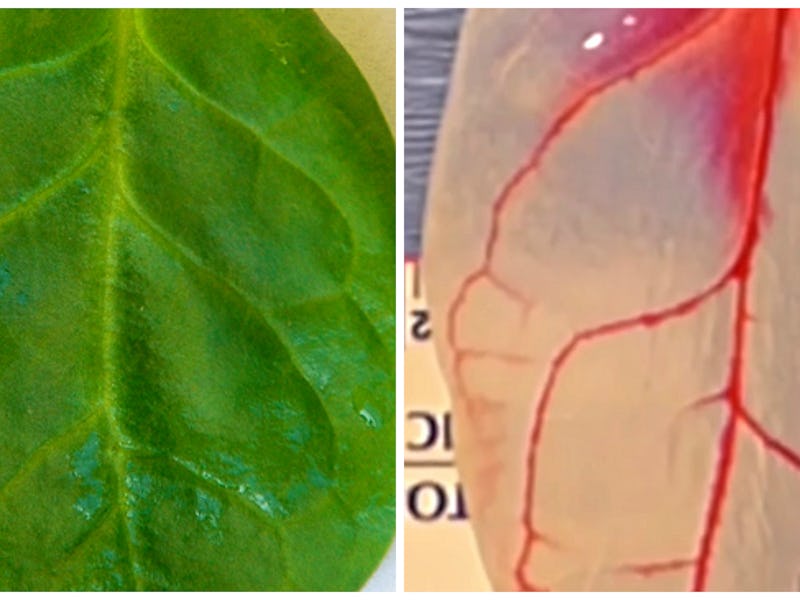Scientists Turned Spinach Salad Into a Living Heart

As far as leafy greens go, spinach is kind of meh. In a different era, it enjoyed brief popularity thanks to a certain huge-muscled sailor, but it’s since given up the limelight to sexier leaves like kale and arugula. Now, spinach is poised to make a comeback — but not on our lunch menus. Scientists have discovered that spinach can be used to grow tissue for human hearts.
Yes, literally: A team of Worcester Polytechnic Institute scientists report in the May issue of the journal Biomaterials that they’ve taken regular spinach leaves from the grocery and pumped them full of heart cells to create a beating heart, complete with veins and blood perfusion. Spinach and heart tissue may seem like a random pairing, but understanding why the scientists did this requires looking up close at a spinach leaf: It contains a highway of vessels like any human organ, only its network of veins is used for shuttling around its own nutrition-filled fluids, not blood. When scientists build synthetic organs like hearts out of cells, one of the biggest obstacles is figuring out how to insert those blood vessels.
Since spinach already has veins, the researchers thought, why bother making them from scratch?
Why make veins when spinach already has them?
To turn the spinach leaves into “scaffolds” for heart cells, they performed a process known as decellularization: Chemicals were used to eat away the actual plant cells, which left behind the plant’s skeleton of tough vasculature made from cellulose (the sugar-based compound that gives plants their rigid structure).
The process of decellularization eats away at the spinach leaf's cells and leaves behind its cellulose structure.
Next, the scientists filled in the newly empty areas with human heart cells, and they co-opted the plant’s veins to act as blood vessels by dripping blood through its stem, which one scientist in the study said resembled an “aorta.” A steady IV drip of blood through this vegetable vein could keep the heart cells alive as if they were hooked up to a living organism.
Dissolving a spinach leaf's cells leaves behind its tough vasculature, which make great makeshift blood vessels for human organs.
This experiment is more than just a gnarly feat of science: The researchers’ findings are going to be very useful for scientists figuring out how to bioengineer human tissue for transplants. The heart tissue grown on spinach could, in theory, be transplanted into a body: Cellulose isn’t toxic to humans, and with the right compounds, the spinach blood vessels could be coaxed into joining with a human body’s existing vascular system. But that will take further research, the scientists point out — they still have to figure out where to put the blood that flows out (currently, it just drips from the bottom of the leaf).
It’s not the first time scientists have used nature’s structures for their research needs — the Ottawa University scientist Andrew Pelling famously turned apple slices into ears and has used asparagus to grow spinal cords — and given the likelihood that nature’s scaffolds will be successfully integrated into damaged human body parts, it definitely won’t be the last. Perhaps old Popeye was a lot more prescient than he let on: It seems spinach very well can make us stronger — just not in the ways we might at first think.